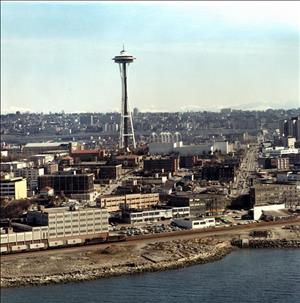In December 1976, Michael Heizer (b. 1944) completes installation of his minimalist sculpture Adjacent, Against, Upon in Seattle's Myrtle Edwards Park. At the time of its unveiling, the set of three blocks of granite resting on or near concrete slabs stirs controversy over its concept and costs. In time, the artwork becomes an important part of Seattle's waterfront landscape.
Taking Place
In 1973, Seattle passed a 1 Percent for Art ordinance, which set aside 1 percent of capital-improvement-project funds for the commission, purchase, and installation of artworks in a variety of settings. Some of the earliest artworks funded by the ordinance were smaller pieces placed inside municipally owned buildings. One of the first large-scale outdoor projects began in 1975, when proposals were requested for a sculpture to be placed in what was then known as Elliott Bay Park.
The land for the park, located on the waterfront at the foot of Thomas and Bay streets just north of Broad Street, was purchased in 1972 using money from the 1968 Forward Thrust bond issue. Prior to acquisition, the land had been used as a dumping ground for detritus excavated during the construction of Interstate 5. It was also one of the city's remaining hobo jungles. Some members of the Seattle Parks Board initially had doubts about the site, claiming that the cost of developing it into a park would be too costly.
Work on the park began in the summer of 1975, under the guidance of Jongejan/Gerrard/Associates, a Bellevue landscape architecture and planning firm. Plans called for the rubble to be moved down to the bank to control erosion along the shore. The resulting open space would then be planted with grass and trees, and traversed by bicycle and pedestrian paths.
Proposals were made for an art installation, with a proviso that the artist help in cleaning up the rubble. One of the proposals was submitted by Buster Simpson (b. 1942), who had recently arrived in Seattle and had begun to impress people with his eco-art installations. Simpson's proposal for Elliott Bay Park would have retained much of the rubble, rearranging the debris in such a way as to make a statement "about what man does when he tears up his creations and discards them" (Collins).
The Seattle Arts Commission gave little support to Simpson's proposal, and instead chose Michael Heizer for the sculpture project. Heizer, an earthworks artist, had already received some renown for his ongoing and massive City project in Nevada, built only with earth, rocks, and concrete. The Arts Commission approved $20,000 for his piece at Elliott Bay Park, contingent on $20,000 more coming from the National Endowment for the Arts and another $20,000 coming from private donations.
Changing Minds
As Heizer began preparing his piece, Elliott Bay Park underwent a name change in honor of city councilwoman Myrtle Edwards (1894-1969), who died in a 1969 car accident. Soon after her death, the city named a park on Lake Union in her honor, but when redevelopment of that park site included the retention of an old industrial plant as a sculpture, Edwards's family requested that her name be withdrawn, and that park was renamed Gas Works Park. In 1976, Elliott Bay Park became Myrtle Edwards Park.
In the meantime, details of Heizer's sculpture were announced. Named Adjacent, Against, Upon, the piece was made up of three enormous natural granite slabs resting on or near three concrete plinths. The first slab would be on top of a three-sided plinth, the next block rested against a four-sided plinth, and the final piece of granite would be placed next to a five-sided plinth. In this way, as the human-created platforms became more complex, the natural rock formations became more distant.
Before it was even installed, the sculpture met with controversy. Some felt that it would be too minimalist for the site, while others wondered how three giant rocks could cost so much money. The family of Myrtle Edwards protested that the sculpture was not appropriate for a park named in her honor. The park board briefly considered moving it to another park, but decided to keep it in its original location, which board members felt suited it best.
Making Art
Each of the granite blocks was quarried in the Cascade Mountains and transported to the site by barge and rail. The two larger boulders weighed in at 45 tons, and the smallest at 28 tons. Heizer found another block at the quarry that he would have liked to try out, but the project's budget -- which had ballooned to more than $80,000 -- had already maxed out.
The extreme costs of excavating and transporting the granite also meant that Heizer had less time to move the pieces on site and play with their placement. He felt this was one of the many compromises he faced in the installation. Referring to his city contract, he told The Seattle Times, "I never worked with so many rules before" (January 12, 1977).
The installation of Adjacent, Against, Upon was completed in December 1976, and the sculpture was met with some negative reviews from the public ranging from puzzlement to outright consternation. City officials quickly responded by pointing out that most of the money spent on the project went right back in to the Seattle economy through "local contractors, equipment-rental houses, material suppliers and so on," with Seattle Arts Commission executive secretary John Blaine also noting that "works of art are, by their very nature, controversial" (The Seattle Times, February 10, 1977).
But while Adjacent, Against, Upon had its group of vocal detractors, it also had proponents. Controversy over the artwork simmered for a few years, but eventually tapered off as more people visited the park and enjoyed sitting on the stones to enjoy views of Puget Sound. Today, whole generations of children have grown up after years of playing on the sculpture and consider it one of the city's most memorable pieces of public art.

